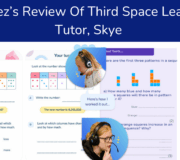Group Tutoring Vs One To One: How It Compares For Cost & Effectiveness
Group tutoring and one to one tutoring are some of the best evidenced interventions to support students’ attainment, with students making between 3 and 5 months’ progress. According to the Education Endowment Fund, this is especially true for disadvantaged students.
As teachers and school leaders, we want our pupils to make rapid and sustained progress in their school journey. When considering implementing tutoring in schools, there are two fundamental intervention options to consider: small group tutoring – interchangeably known as group tuition – or one to one tuition.
This article explores the advantages and disadvantages of group tutoring and one to one, looking at their effectiveness and impact on pupils, considering factors such as budget, time, flexibility and personalisation. It aims to support teachers and school leaders to choose the right approach for their school and students.
What is group tutoring?
Group tutoring is when a professional tutor works with a certain number of pupils in a group setting to help close any learning gaps they share in common. Typically, it takes place in a tuition centre or classroom, very similar to a classroom we associate ourselves with.
The number of pupils in group tutoring sessions can vary, ranging from small group tutoring sessions of 2 or 3 pupils to larger groups of up to 4 or 5 pupils.
While some consider groups of over 6 as group tuition, this is somewhat debatable and more accurately reflects group teaching. When groups become too big for focused attention on pupils and personalised teaching, the effect of the tutoring decreases.
With group tutoring in schools, the tutor will focus on specific areas of the curriculum to deliver quality instruction focused on the pupils’ areas of development. Many schools focus on core curriculum areas, including English, maths and science. The small groups allow for group interaction and time for individual practice where pupils work at their own pace.
How effective is group tutoring?
A recent study by the EEF found that small group tuition has an average impact of four months’ additional progress over the course of an academic year in primary schools. There is a noticeable reduction in impact among secondary pupils who averaged two months’ additional progress.
Group tuition is also likely to be most effective when pupils are selected and grouped carefully, for example all working on the basic fundamentals of maths, so that their specific needs can be targeted by the tutor. This requires accurate diagnostic assessment prior to tuition commencing and, if done well, this can be a powerful tool in closing the gaps for pupils from disadvantaged backgrounds and a strength in the Pupil Premium strategy.
However, caution beckons here as should the group size increase more and more, the impact on student outcomes reduces as tuition will resemble more of a ‘normal’ classroom atmosphere and pupils will get less out of it.
The Ultimate Guide to Maths Tutoring
A guide on how to choose, plan and fund the right tutoring approach for your students for maximum impact in your school.
Download Free Now!Advantages of group tutoring
- More personalised learning than with the whole class: While more difficult than it is for one to one tutoring, personalised learning for pupils is possible within small group tuition. It requires detailed diagnostic assessment to enable personalised learning within sessions. This can also provide targeted provision for those who are quick thinkers and need small group classes to stretch their learning, as well as those who are currently lower attaining and require support to address gaps in their learning.
As identified by the EEF, low attaining pupils do typically benefit more from small group sessions, particularly if frequent sessions across the week are provided with consistency. However this can create timetabling complications – especially for those in secondary schools!
- Opportunities for peer learning: Small groups enable the tutor to deliver instruction using quality resources and equipment to engage the pupils in a purposeful learning environment. There is an opportunity for peer collaboration in tasks as well as personal, friendly competition – something which is not possible in one to one tutoring.
At GCSE and A level standards, the collaborative mentality and exploration into subject matter with fellow learners can enhance confidence, self-esteem and understanding.
- Lower cost: For school leaders, there is an obvious cost implication that favours small group sessions. In most cases, the cost of small group tutoring, whether in person or online, is often a cheaper alternative to one to one tuition and schools can provide tuition for more pupils with fewer tutors.
Through our AI maths tutor, Skye, here at Third Space Learning, we’re able to provide affordable one to one tutoring for schools for less than the price other providers charge for group sessions.
- Removes stigma: The EEF found that group tutoring reduces the potential stigma associated with tutoring, as pupils are with their peers.

Meet Skye, the voice-based AI tutor making maths success possible for every student.
Built by teachers and maths experts, Skye uses the same pedagogy, curriculum and lesson structure as our traditional tutoring.
But, with more flexibility and a lower cost, schools can scale online maths tutoring to support every student who needs it.
Watch Skye in actionDisadvantages of group tutoring
- Impact: Less impactful than one to one tutoring and less effective in secondary schools (+2 months’ progress) than primary schools (+4 months’ progress).
- Diagnostic assessment: Requires complex student matching to ensure students are working on learning objectives that they need extra support with and can work at a similar pace.
- Group size: The larger the group, the more impact drops off (evidence suggests that once group size increases above 6 or 7 there is a noticeable reduction in effectiveness).
- Timetabling issues: For any provider or school, timetables can be a logistical nightmare. Even more so with small group tuition. Ensuring the tutoring programme is accessible for all pupils and promotes student attendance while ensuring that they are not missing vital elements of their studies can be a difficult task. You do not want to be providing tutoring services in one subject and creating difficulties in another!
- Tutor training: Tutors typically require more training to be effective as group tutoring is more challenging to deliver.
- Pupil confidence: Group tuition is not suitable for all children. Some children remain shy in small groups or may not react well to the enhanced attention of a small group and so do not like to give answers in front of their peers.
In circumstances such as this, one to one tuition would be a better consideration as there is more focused attention and support with a well matched tutor a pupil knows and trusts, they will feel safe and confident in discussing correct strategies, answers and misconceptions.
The one to one intervention supports individuals. I also like that pupils who might not be confident to speak up in class feel it is a safe space to say they are unsure of the learning that might be taking place.
Headteacher and Third Space Learning customer, London
How to make group tutoring a success
Group tuition can be successful – if you put the leg work in initially, it can pay dividends. However it requires planning and you must carefully consider size, space, subject matter and students.
This means ensuring the group is targeted specifically for those who need it. In turn, this reduces the number of students in a group and keeps it as an effective small group intervention whereby the correct students are there and have been accurately identified through diagnostic assessment. Do not just invite low achievers as their subject knowledge, misconceptions and learning gaps in maths will vary greatly from one another.
Carefully consider the content that the tuition will be covering and ensure the provider has the correct resources (that align with classroom teaching), the correct working space and the correct strategy to make the most out of every session.
What is one to one tutoring?
One to one tutoring is what, as educators, we would love to provide with regularity but in a class of 30, it’s physically impossible for one teacher to give each pupil this kind of individual attention. That’s where additional one to one tutoring comes in. It’s when one qualified teacher, teaching assistant, professional tutor or AI tutor provides intensive, personalised learning to one pupil.
No matter how much of a good teacher you are, you can never get to 30 children and do 30 different pieces of work and that is what is needed. Because it is one to one and to their level, it is the best type of intervention you can have.
Angela Kershaw, Maths Leader and Third Space Learning customer, St. Augustine’s Academy
If using traditional tutoring, the provider for this will hold a valid DBS certificate and will support the learner with tutoring sessions to bridge gaps that have formed, address misconceptions, consolidate learning and/or stretch learning even further.
With one to one tuition, there is space for personalised learning, giving focused sessions that build on individual strengths and development areas, whether in person or via online tuition.
The EEF found one to one tuition to be a very effective intervention and that if short, sharp, regular sessions take place then the impact can be vast. Over 5 months’ progress can be made across a year with, on average, 6 months’ progress in the primary setting and 4 months’ progress in secondary schools. In contrast, the impact of group tutoring on pupil progress is 4 months at primary school and 2 months at secondary school.
Online one to one tuition has similar effects to in-person one to one sessions.
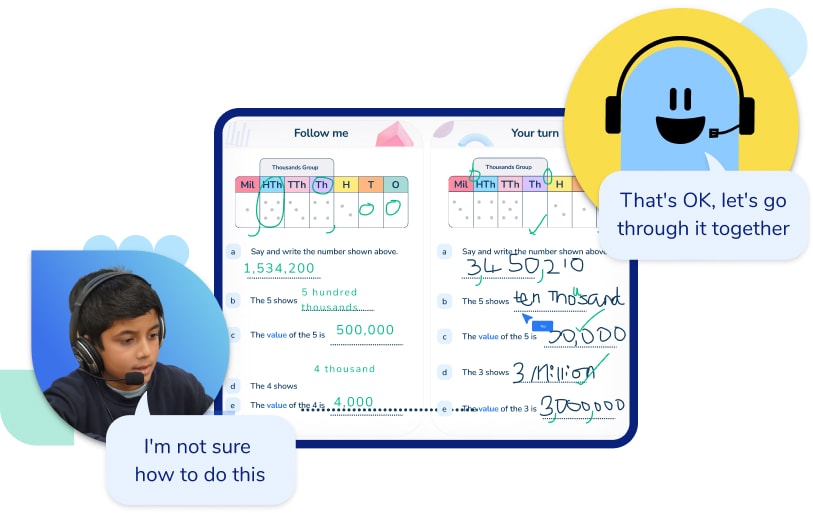
Advantages of one to one tutoring
- Impact: With one to one tutoring, over 5 months’ progress can be made across a year with, on average, 6 months’ progress in primary school tutoring and 4 months’ progress in secondary schools. In contrast, the impact of group tutoring on pupil progress is 4 months at primary school and 2 months at secondary school.
- Hyper personalised: Individual, focused attention for the pupil through personalised sessions is a huge advantage of one to one tutoring. As teachers and school leaders, we would want to ensure all our children achieve this in class but the reality is that it is not always possible.
One to one tuition provides the opportunity for pupils to work through a bespoke curriculum based on their individual learning gaps and misconceptions. It also works at the pace of the learner and gives ample opportunity for learning, application and personalised feedback, with few distractions.
- Rapport: It is easier for tutors to develop a rapport with pupils and create a positive learning environment. This in turn increases pupils’ enjoyment of the sessions.
- Pupil confidence: Once a positive learning environment has been established, pupils can benefit from the individualised support of their tutor in a low stakes environment. Pupils can make mistakes and learn from them, without worrying about other classmates.
The children have loved the personalised learning and having a one to one lesson. It has been lovely to hear them explain their thinking.
Karan Johnson, Teacher and Third Space Learning customer, Moss Hall Junior School, Barnet
Disadvantages of one to one tutoring
- Cost: This can actually be a red herring as a disadvantage. On the face of it, one to one tutoring costs more than group tuition, whether online or in person. However, one to one tuition can actually be more cost effective. There are also ways of reducing the cost of one to one tutoring, such as opting for online tutoring or AI tutoring. Learn more here: best online tutoring websites.
While the decision for schools may depend on their initial budget at the start of a new school year, the cost of one to one tutoring can be moderate and more effective in the long term, provided that schools are using experienced and effective providers and that impact is monitored regularly and accurately.
Third Space Learning is just as effective as bringing in a one-to-one tutor but it’s so much cheaper, so you can afford to have more children doing it. Plus, the children love it and they’re so enthusiastic about it! What’s not to like? It’s cheaper, the children do just as well and they really like it!
Clare Sealy, Headteacher, St. Matthias Primary School, London
- Scale: One to one tutoring can be difficult to scale to a large group of students without multiple tutors, making it challenging to deliver in person. Online tutoring can help to combat this.
- Pupil needs: One to one tuition is not for everyone. Some pupils feel pressurised in the one to one tutoring learning experience and so may prefer the environment provided by small group tuition. However, this is also why finding the correct provider with high quality, trained tutors is essential to maximising the progress from tuition in the first place.
AI maths tutoring
While traditional tutoring is effective, AI maths tutoring can offer a high-quality alternative that removes the constraints of timetabling, tutor availability, and per-session costs allowing even more pupils to benefit from one to one maths tutoring.
The best AI tutors have the potential to serve unlimited pupils at any time, instantly diagnosing errors and adapting scripted prompts for consistent, curriculum-aligned practice. However, AI maths tutors cannot replace quality first teaching and must use human teacher and subject specialist expertise. That’s why Third Space Learning’s AI maths tutor, Skye, has been built by our team of teachers, curriculum designers, and maths experts using everything we’ve learned from delivering more than 2 million live lessons to over 170,000 pupils.
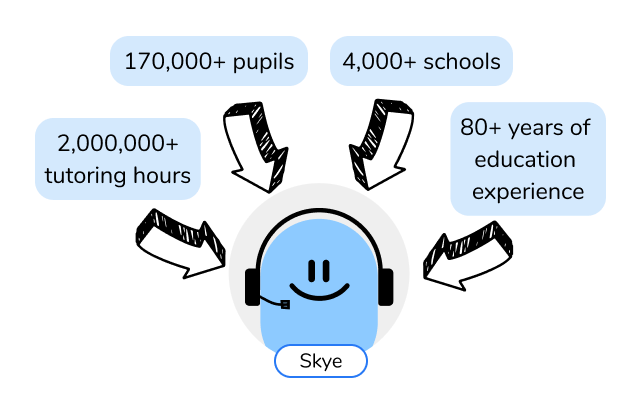
Unlike chatbots or other generic AI solutions that rely on text-based learning, Skye is a voice-based tutor that works by talking students through maths problems; speaking, listening, and scaffolding them through step by step explanations at their own pace. With Skye, you can support as many students as need it, with as many sessions as they need, for one low yearly price starting from £3500.
Find out more about online one to one AI maths tutoring with Skye:
How to make one to one tutoring a success
One to one tutoring can be one of the most impactful interventions we can provide as teachers and school leaders. Once you have selected the best provider and tutor for your school’s needs, consider how to make the most out of your chosen tutoring approach.
Initial diagnostic assessment, regular feedback from the tutor and regular assessment will ensure an accurate learning journey that is always focussed on plugging learning gaps. This not only ensures value for money, but also value in time which, as we know, is always at a premium in the education sector.
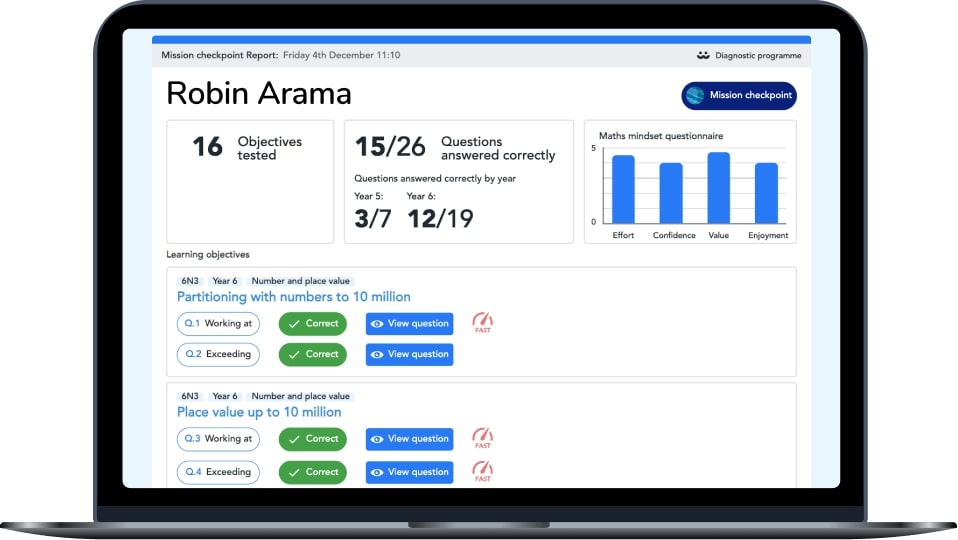
Post session questions assess understanding after every session
to ensure their personalised learning pathway is always up-to-date and accurate.
Ofsted’s report into tutoring
Ofsted’s research suggests that effective tutoring can be a valuable tool in supporting students to catch up, following school closures and disruptions to learning due to Covid-19. However, this is provided that the tuition is personalised to meet the needs of the individual, delivered by quality, skilled and knowledgeable tutors and that the content aligns with students’ lessons in the classroom.
In short, Ofsted concluded that:
- School-led tuition is the preferred choice among schools as leaders have more control over the hiring of tutors, delivery of the sessions and the content covered. However, this results in extra workload for the school.
- Tutoring during the school day was more effective, particularly in secondary schools, and so efforts should be made for it to take place during school hours.
- Where tutoring is delivered by high quality tutors, Ofsted saw that in over half the schools, it was delivered well and impactful.
- Tuition was of higher quality when qualified teachers were involved. Weaker sessions were delivered by tutors who lacked sufficient training, resulting in poorly planned sessions with content poorly matched to student level.
- Students were overwhelmingly positive about tutoring.
- Many schools had not yet developed effective ways to assess student progress.
- If planned accurately and in line with the school curriculum, tuition can be a powerful intervention.
What does this mean for my school?
- Consider the resources available to you, including staff availability
- Try to schedule interventions during the school day
- Ensure all tutors have received training
- Consider how you will monitor and assess student progress
- Ensure tutoring content and curriculum aligns with your school
Blending both group tutoring and one to one tutoring
Group tutoring may be the right choice for some of your pupils but for most, one to one tutoring will make a larger impact on their learning outcomes and be a more cost effective intervention. Time and money are both priorities within school so it is important to make decisions that will have maximum impact – and consider how AI tutoring may help you deliver the benefits of one to one tutoring to a larger number of pupils.
With maths in mind, it’s important that pupils have space to delve into mathematical concepts, are taught in a way that aligns with their classroom lessons and that misconceptions are addressed in real time, all of which are best achieved through one to one tuition. Online one to one tutoring offers a more affordable route to the benefits of one to one tutoring and may be the right choice for your school.
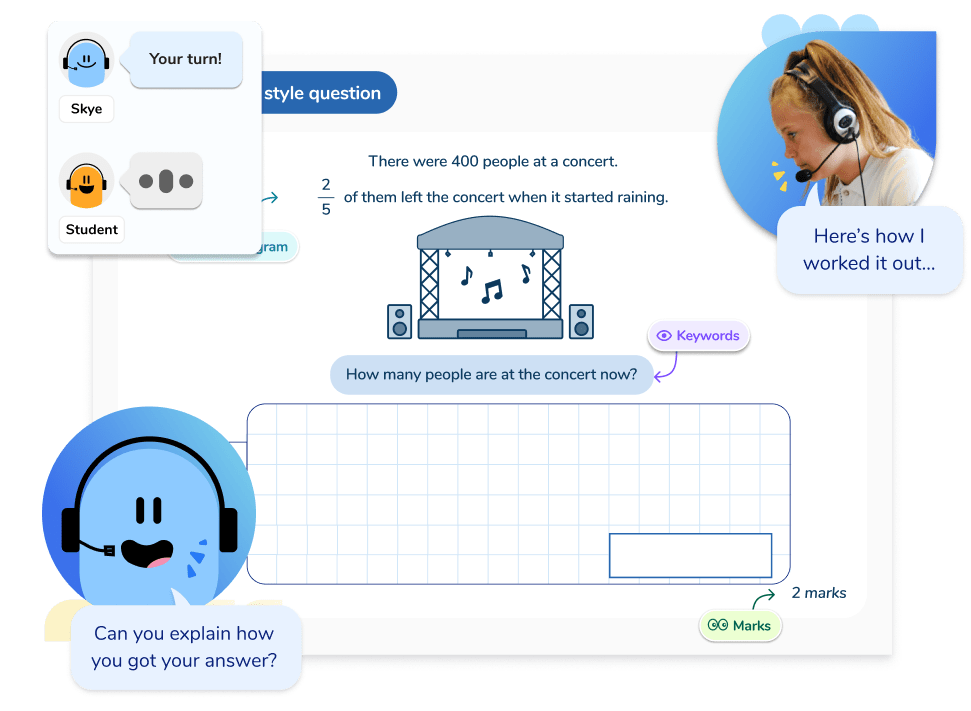
At Third Space Learning, we’ve developed Skye, an AI maths tutor. Skye is designed to mimic the teaching methods of pedagogically sound subject matter experts, drawing on our decade of experience working with thousands of primary and secondary schools. Skye adapts the pitch and pace of the session and personalises the instruction to suit each learner and uses tools like modelling, scaffolding, real-life contexts, and encourages verbal reasoning to help pupils solve problems, catch up and excel – even feel excited about maths!
Our curriculum and resources are carefully designed and reviewed by our academic team, made up of experienced former UK teachers, and lessons follow an “I do, We do, You do” approach using teacher-crafted scripts. This ensures that the content and teaching approach aligns with what pupils are being taught in the classroom.
All pupils take a diagnostic assessment before they begin tutoring which informs their individualised learning journey, addressing their misconceptions and plugging gaps in their learning. The personalisation doesn’t end here; pupils complete post-session questions to track their progress and ensure future sessions are aligned to their individual needs. We provide on-demand reports for teachers so you can make sure the tutoring is making an impact on your pupils’ outcomes.
Group tutoring FAQs
In a traditional classroom, one teacher must meet the needs of 30 learners. In small group settings, students benefit more personalised attention and small group collaboration with their peers, thus building communication, discussion and listening skills around the tasks at hand. It can also be more cost effective for schools in the short term and as identified by the EEF, it can bridge the disadvantage gap if carried out well.
There are two different types of tutoring: one to one tuition or group tuition. They can both be delivered either in person or online and take a traditional approach or use AI. Parents may also consider private tutoring options at tutoring centres or in the home, where private tutors travel to you and your child.
The alternative to group tuition is one to one tuition, whether online or in person or traditional or AI. One to one tutoring is typically the option that provides the pupil with the most impact and gives a more personalised, focused tuition experience.
Generally, the larger the group, the less impactful group tutoring becomes. This is because it is more challenging to deliver highly-personalised instruction and give detailed feedback to larger groups of students. There are also issues around timetabling, tutoring training and student confidence.
DO YOU HAVE STUDENTS WHO NEED MORE SUPPORT IN MATHS?
Skye – our AI maths tutor built by teachers – gives students personalised one-to-one lessons that address learning gaps and build confidence.
Since 2013 we’ve taught over 2 million hours of maths lessons to more than 170,000 students to help them become fluent, able mathematicians.
Explore our AI maths tutoring or find out about one to one tuition for your school.






